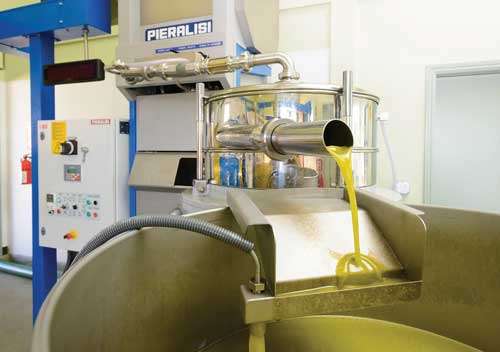Olive Oil – Press Time:
After olives are picked, any leaves, twigs, and stems are removed, and the olives are washed. Then it’s time for pressing. Back in the old days, processors used stone or granite wheels to crush the olives.
Today, stainless steel rollers crush the olives and pits and grind them into paste. The paste then undergoes malaxation, a process in which water is slowly stirred into the paste. Malaxation allows the tiny oil molecules to clump together and concentrate.
The mixture is stirred for 20 to 40 minutes. Longer mixing times increase oil production and give the oil a chance to pick up additional flavors from the olive paste. However, the mixing also exposes the oil to air, producing free radicals that poorly affect its quality.
Modern systems use closed mixing chambers filled with a harmless gas to prevent oxidation. This method increases yield and flavor and preserves quality. The mixture may be heated to about 82 degrees Fahrenheit, which further increases yield but does allow some oxidation. This temperature is low enough to be considered “cold pressed.”
Next, the paste is put on mats and further pressed or sent through a centrifuge (a compartment that is rotated on a central axis at extreme speed to separate materials). When the centrifuge spins, the olive paste remnants are pushed to the sides of the compartment cylinder while water and oil are extracted from the center of the centrifuge. The oil and water are later separated.
The solid material that remains after the extraction of the oil is called pomace, and it contains residual oil. Some manufacturers will use steam, hexane, or other solvents to squeeze more oil out of the pomace. This low-quality oil must be labeled as pomace oil.
Oil may then be refined, bleached, and/or deodorized. Refining reduces acidity and any bitter taste. Bleaching removes chlorophyll and carotenoids (naturally occurring pigments that give plants their colors) and possibly pesticides, resulting in a light-colored oil with fewer nutrients. Deodorizing removes the fragrant aroma of the olive oil.
In the manufacturing plant, oil is stored in stainless steel containers at about 65 degrees Fahrenheit to prevent breakdown before it is bottled and shipped.
Lots of different types of olive oil come out of the presses. On the next page you’ll learn what all the label terms mean and what’s inside each of the bottles.






